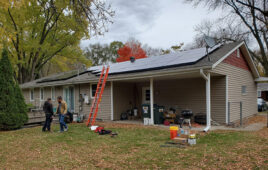The rapid adoption of solar energy systems by Georgia home and business owners under Georgia Power’s “Monthly Net Metering” program is about to grind to a halt and could threaten solar jobs in the state. When the Public Service Commission established the program in 2019 it placed a cap on the number of customers that could benefit from monthly netting. That cap has now been reached.
“For the first time in state history, Georgia Power customers with solar panels on their homes or businesses can get full credit for energy exported to the utility,” said Montana Busch, co-chair of the Georgia Solar Energy Association and CEO of Alternative Energy Southeast, headquartered in Athens. “This policy has helped to create hundreds of new jobs in one year. If the PSC’s cap stands we will lose many of these good paying jobs”.
Monthly net metering is a basic utility policy that credits solar customers at the retail rate for the solar energy fed back into the grid, required in Georgia’s 2001 Co-Generation and Distribution Act. An analysis provided by the Southern Environmental Law Center shows monthly net metering as an industry-standard utility solar policy. Under Monthly Net Metering, customers essentially get credited the full retail value of their solar (up to their monthly usage) instead of the wholesale rate (⅕ of the avg. retail rate) Georgia Power previously credited for all solar exports.
Georgia Power’s monthly net-metering program was created as a part of the 2019 Public Service Commission (PSC) Rate Case with the support of the Georgia Solar Energy Association. Public Service Commissioner Tim Echols added a cap of 5,000 customers or 32 MW of capacity, whichever comes first. Under this program, rather than instantly crediting a customer’s excess solar generation at wholesale prices, the utility uses excess solar power to offset consumption, thereby further reducing the customer’s bill.
“The pilot monthly net-metering program has been a big success for Georgia Power customers and the growing solar industry” said Russell Seifert, CEO of Creative Solar USA in Kennesaw, Georgia. “We’ve been in the state for 13 years and the adoption of the monthly net metering program for Georgia Power was a signal to us that Georgia was finally becoming a mature solar market. Now isn’t the time to put a cap on Georgia’s solar opportunity. Neighboring southern states already have many times more than Georgia Power’s 5,000 customers with onsite solar: South Carolina with over 20,000; Florida with almost 60,000.”
Georgia’s solar industry has added dozens of new companies and thousands of new solar installations under the program in 2021. Now that the caps have been met, Georgia Power customers interested in solar energy will only be able to recoup wholesale power costs from excess energy they produce. If the Public Service Commission does not extend the program, the Georgia Solar Energy Association warns that hundreds of solar jobs are at risk as companies re-evaluate their presence in the state.
According to the Solar Energy Industries Association, Georgia is currently ranked 9th amongst all states for the amount of solar energy installed with one of the fastest growing solar job markets in the nation.
Georgia Solar Energy Association plans to hold webinars for solar installers and solar owners interested in learning more about the monthly netting caps and urged interested parties to visit www.gasolar.org for updates.
News item from the Georgia Solar Energy Association





Well said, sir. True net metering should be the even trade to the utilities for not having to create/buy so much power and then distribute it for many miles. We must take into account that at least 2% of the utility’s energy is lost through high voltage transmission and then also there’s the additional 4% loss that happens over local and residential lines coming into the home. Those figures can be greater depending in the quality of the grid they’re on. Homes producing solar kWh’s should be well compensated for pushing their excess energy to their next-door neighbors due to the compounded benefit the utility receives by not having to absorb so much energy loss through transmission. I wonder, how often does energy created from, let’s say, a group of solar homes in a neighborhood ever make it back to a sub station before being absorbed by other neighbors?
Georgia has been solar PV ‘unfriendly’ from the start. Over the years has been resistant to changing their alternative energy policy. The problem I see now with the electric utilities is they are completely ignoring bi-directional grid operation where the DER sector be it a residential, small business or even an aggregate housing tract with the summed ability to produce MWh of stored energy for later use. The reluctance of accepting a bi-directional grid with digitization allowing this type of real time communications to create bi-directionality of the grid for public use possible.
Net energy metering, is a selfish view of the energy market. As a cooperative of generators, market delivery and consumers all working together to keep power and prices stable. The view of just because A generation system has no ability to manage its output to coincide with user demand is flawed if the rest of the market has that obligation. Net metering is disrespectful of LMP.
So, far LMP is not a consideration with the rote utilities either. Recently bills have been pushed like HB6 in Ohio to force ratepayers to subsidize the old nuclear and coal fired plants to keep them open. California tried AB 1139 trying to get rid of net metering and forcing in net billing at the wholesale rate for energy credits also disrespects the ratepayers by not having an “effective” rate for a distributed energy generation resource that shouldn’t have TD&D, “fuel charges”, demand charges, fees, tariffs for energy that comes from miles away.
As far as “obligations” are concerned, the electric utilities could well assert an interactive bi-directional grid to serve all of its customers, but still want’s the uni-directional generate and dispatch system they’ve enjoyed for about 120 years. All these utilities need to do is find regional and local nodes for energy storage and the whole grid infrastructure becomes more robust.